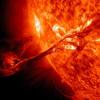So far tessellation uptake is extremely low. This is both because of low hardware penetration (it's not available on a console yet, most PC users don't have a DX11-level GPU) and because it's both expensive and difficult to use effectively. PN Triangles and Phong tessellation are pretty similar, and aren't terribly useful. They can improve the look of certain organic shapes but they require a lot of tuning to get right, and possibly per-vertex parameters. I haven't heard of anybody even being interested in Catmull-Clark or subdivision surfaces in general. It's not a good match for existing artist workflow, and you Catmull-Clark surfaces can't even be fully implemented on DX11 hardware since the algorithm is recursive. Displacement mapping is probably the most useful on paper, but in practice it has a lot of issues that need to be worked around. Avoiding cracks at UV seams is particularly expensive, since you need to guarantee consistent tessellation factors across all adjacent patches.
There are also some special-case situations where tessellation can be used (terrain, water, and hair come to mind) but I'm guessing that you're interested in that?
I'm mostly interested in it as a thesis area. So long as I can assume that the general PC user will have it in 5 years, its fair game on my end. I'm beginning to notice why Phong and PN tessellation aren't well liked. It seems like they may have a place, but they aren't very general purpose.
Catmull-Clark surfaces (and many other subdivision schemes) converge to an analytically obtainable limit surface which can be represented as a network of bicubic bezier patches. The "Feature Adaptive GPU Rendering of Catmull-Clark Subdivision Surfaces" and "Ef?cient Evaluation of Semi-Smooth Creases in Catmull-Clark Subdivision Surfaces" papers address their realtime performance quite well and it looks fairly promising. I'm admittedly not familiar enough with render budgets to know how good 1-2ms is for a car, but it seems good enough to me. My only comparison point right now is 3.4ms on the same model card for Valve's displacement mapped monster frog model; a rather unfair comparison.
I've been looking into eliminating seams in displacement maps recently. I located a paper (http://lgdv.cs.fau.de/get/1682) which appears to have found an interesting solution. They eliminate the seams by natively storing the data along with the mesh. The results look promising to me, but their indexing scheme and cache coherency leave something to be desired. If I could find a better indexing scheme, it might be well suited for games (as it also solves the swimming problem). I'd be interested in hearing what you think about it.
I'm actually interested in basically every use of tessellation in games right now, though I have started with surfaces. If you could point me to any good sources for terrain, water, or hair, that would be awesome :)
I thought PN triangle tesselation was quite useful for characters ? At least crytek has been using it in their engine for characters (or at least their heads  ) afaik.
) afaik.
In my own little test it also seemed to look quite nice. The only problem I had was cracks. Had to disable it and haven't picked up on that since then...so I'd also be interested to know why it fails in your opinions ?
That does seem to be one of the better uses for it. It really fails when you want a surface without smooth normals.
Once I've worked the algorithmic bugs out of my algorithms so far, I haven't seen any cracks... If you want, I can post my PN shaders (GLSL) when I'm done with them. My standard license is WTFPL (http://en.wikipedia.org/wiki/WTFPL).









